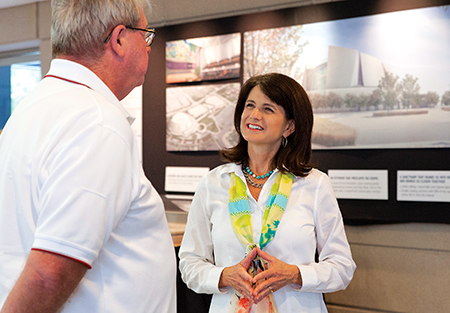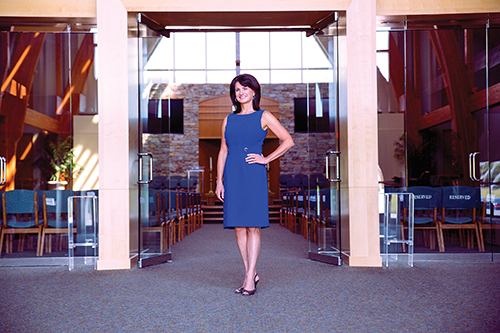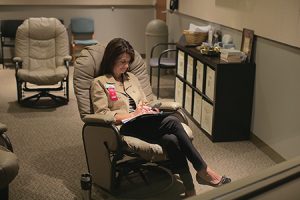
DEBI NIXON
Managing Executive Director | Church of the Resurrection | Leawood, KS
Debi Nixon wears many hats at Church of the Resurrection, a United Methodist congregation of nearly 20,000 members. Her title is broad in scope; but to put it succinctly, she’s a connective leader, helping the church implement its vision and move forward in the right direction.
By Rez Gopez-Sindac

As a member of the managing executive team that serves alongside senior pastor Adam Hamilton, Nixon is the liaison between the main campus (Leawood) and the regional campuses, ensuring that the Resurrection DNA is consistent in all locations. She represents the voice of the campus pastors in decision-making and helps secure the resources they need to put their strategies into action.
Nixon serves as the coordinator of the church’s capital campaigns across all campuses. Most recently, Church of the Resurrection raised $63 million to complete the main campus’ sanctuary and renovations. Also, Nixon is the author of CATCH: A Churchwide Evangelism Program that provides practical ideas on ways to extend radical hospitality, do outreach and marketing, and create processes and systems for connection and discipleship. In addition, she oversees the Catalyst Ministry and helps coordinates staff development, budgeting and church planting.

Nixon grew up in a home where weekly worship was important. Yet, as a young adult, other interests — like college, marriage and career —ˆ got in the way of making church a priority. Her husband, Reed, grew up in an unchurched home. In 1991, they started looking for a church family and found Church of the Resurrection. Nixon joined the staff in 1994 as the first director of children’s ministries. She had no experience or theological training, only an invitation from Hamilton “to be a part of something that might change the world.”
“It was a vision that captivated my heart, and still does today,” says Nixon.
Tell us something about Church of the Resurrection.
Church of the Resurrection is a congregation with a passion to build a Christian community where nonreligious and nominally religious people are becoming deeply committed Christians. We are one church, worshipping in four different locations in the Kansas City area. Our journey is to know, love and serve God. We’re united by a common vision, which is to be used by God to change lives, transform communities and renew the church. Our church wasn’t started to reach those who were already churched and were just looking for a better experience. We seek to reach those who are disconnected from church.
 What are the biggest challenges in carrying out your
What are the biggest challenges in carrying out your
various responsibilities?
The biggest challenge is time. We’re a highly entrepreneurial organization, which means we’re constantly changing and evolving. And, we generally tend to hire those with a high entrepreneurial spirit. When you have different context in which you serve — and each of our campuses is located in a different context — it’s important to find ways to be relevant and contextual in each setting, while not capitulating on our core values and non-negotiables as a church. As a result, we’re very engaged in leading the church and keeping everyone moving in the same direction.
Do you have a direct role in starting, staffing and supporting a new church campus?
Yes, I have helped in the launch and ongoing daily support of our campuses. Although I was indirectly involved in the launch of the first two campuses, I was directly involved supporting our campus pastor in the launch of our fourth location, Blue Springs, which required a different strategy. The Blue Springs location was a church that closed its doors and surrendered its building to Church of the Resurrection in June 2010. We launched it in August 2010 as a new church. In many ways, it’s a revitalization story — of a church that lost its vision and was out of money and passion. We looked at the location and knew that this was a community that had a great potential to reach nonreligious people. But it was a harder church launch. Here was a congregation who didn’t realize that things were going to be different — new style of worship, new order, new practices. It took about two years for the culture of that church to completely change and to be the congregation that it is today. We started with 40 people; this past weekend, there were nearly 400 worshippers and children. We had three kids when we launched, now we have 75 to 100 children. And we’ve only just begun.
 What strategies and practices have you found effective in achieving the goals of your job?
What strategies and practices have you found effective in achieving the goals of your job?
The main strategy I have disciplined myself to employ is to not micromanage the activities of our campus pastors or our campuses. I have learned the greatest value I offer is to be in a true supportive role where I’m helping to align their vision and strategies for campus growth through evangelism, outreach and discipleship into action steps, and then helping to secure the needed resources. I also have to balance my responsibility to the overall vision of Church of the Resurrection and the vision of our senior pastor. We practice proactive, open communication that helps us address challenges in a healthy way and capitalize on opportunities. I make it a priority to have a presence on our campuses so I can best connect, collaborate and support the staff and congregants. I have the highest level of respect for my team and my desire is to not get in their way but instead be radically available to support them in their ministry.
Where does the funding come for starting a new campus? What are the financial and stewardship responsibilities of each campus?
Each campus is launched and funded by Church of the Resurrection, with the desire that each campus becomes self-sufficient within five years of their launch. When a campus becomes self-sufficient, they begin to direct some resources back into the general fund to help support future campuses or other churchwide initiatives. We have a comprehensive budgeting process led by our CFO, who is also a member of the managing executive team. Each campus is held accountable for their budgets. We conduct an annual stewardship campaign each fall, and budgets are established based on the results of the pledges committed. We try to have each campus budget closely aligned with the anticipated receipts and offerings.
We recognize that our structure still needs to be changed. We’re working on making a determination on what is our centralized and decentralized support structure.
Quick facts about Church of
the Resurrection
Year established: 1990
Lead pastor: Adam Hamilton ( founding pastor )
Denomination: United Methodist
Number of locations: Four
Combined weekly attendance: 10,000+
2016 budget: $21.8 million
What kind of multisite growth do you envision for Church of the Resurrection?
It’s our desire and vision to add regional campuses and continue to pray and be attentive to the movement of the Holy Spirit on when to launch our next campus. We’ve recently purchased a parcel of land in the southern part of our community for a future campus launch, and we’re praying over other locations.
What’s the impact of your role as Catalyst director on the vision of Resurrection?
Our Catalyst team is committed to initiatives related to our vision of church renewal. We do this in a number of ways, including our annual Leadership Institute held every September which attracts more than 2,000 church leaders around the world. The conference is focused on inspiring and equipping church leaders by the sharing of principles and practices consistent in growing churches. It’s always inspiring to hear of attendees who leave the conference inspired and with a new sense of vision and passion. Catalyst helps coordinate site visits for pastors and church groups, sabbatical leave experiences, and other leadership groups who want to meet at Resurrection. It’s also responsible for our Partner Church ministry, where we serve with churches across the country to share resources, coaching and networking. Imagine the impact of hundreds of already established congregations banding together to share powerful tools in order to provide the very best ministry to their communities!
Why are you passionate about this ministry?
I have discovered in leaders and churches where I speak or consult that there’s a lack of clarity on their purpose and vision. Too often, they’ve become inwardly focused, sometimes because they’re simply trying to survive. Others have focused inwardly for so long they’ve built barriers that keep the church from changing to meet the needs of the ever-changing community. For decades, the United Methodist Church has been in decline, as have most mainline churches. I don’t believe our best days are behind us. I believe they’re in front of us, but it takes leaders who are passionate and outwardly focused. Each community deserves and needs a local church that’s focused on reaching deep into the community, extending radical hospitality, and inviting nonreligious and nominally religious individuals into the loving presence of Christ.


